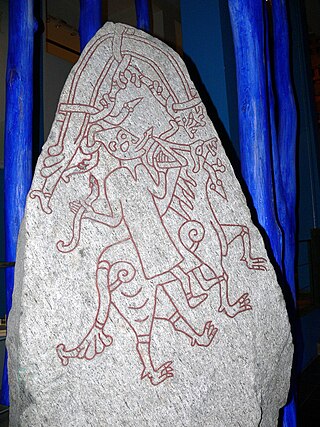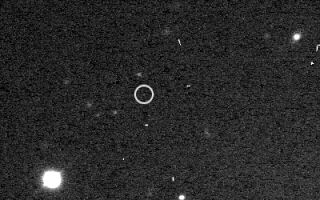Related Research Articles

A jötunn is a type of supernatural being in Germanic mythology. In Norse mythology, they are often contrasted with gods and other non-human figures, such as dwarfs and elves, although the groupings are not always mutually exclusive. The entities included in jötunn are referred to by several other terms, including risi, þurs and troll if male and gýgr or tröllkona if female. The jötnar typically dwell across boundaries from the gods and humans in lands such as Jötunheimr.
Angrboða is a jötunn in Norse mythology. She is the mate of Loki and the mother of monsters. She is only mentioned once in the Poetic Edda as the mother of Fenrir by Loki. The Prose Edda (Gylfaginning) describes her as "a giantess in Jötunheimar" and as the mother of three monsters: the wolf Fenrir, the Midgard serpent Jörmungandr, and the ruler of the dead Hel.

In Norse mythology, Surtr, also sometimes written Surt in English, is a jötunn. Surtr is attested in the Poetic Edda, compiled in the 13th century from earlier traditional sources, and the Prose Edda, written in the 13th century by Snorri Sturluson. In both sources, Surtr is foretold as being a major figure during the events of Ragnarök; carrying his bright sword, he will go to battle against the Æsir, he will battle the major god Freyr, and afterward the flames that he brings forth will engulf the Earth.

Skathi, also named Saturn XXVII and originally spelled Skadi, is a natural satellite of the planet Saturn. Skathi is one of Saturn's irregular moons, in its Norse group of satellites. It was discovered on September 23, 2000, by a team of astronomers led by Brett Gladman. The team announced their discovery on December 7, 2000, along with seven other satellites of Saturn, namely; Tarvos, Ijiraq, Thrymr, Siarnaq, Mundilfari, Erriapus, and Suttungr. The moon was named after Skaði, a figure in Norse mythology, as part of an effort to diversify the largely Greek and Roman names of astronomical objects.

Suttungr, or Saturn XXIII, is a natural satellite of Saturn. It was discovered by Brett J. Gladman, et al. in 2000, and given the temporary designation S/2000 S 12. It was named for Suttungr in Norse mythology, a Jötunn or giant who once owned the mead of poetry.
Farbauti or Saturn XL is a natural satellite of Saturn. Its discovery was announced by Scott S. Sheppard, David C. Jewitt, Jan Kleyna, and Brian G. Marsden on May 4, 2005, from observations taken between December 12, 2004, and March 9, 2005.

The Norse group is a large group of retrograde irregular satellites of Saturn. Their semi-major axes range between 12 and 27 Gm, their inclinations between 136° and 178° and their eccentricities between 0.06 and 0.63. Unlike the Inuit and Gallic groups, the orbital parameters are widely dispersed and the group is likely to be composed from a number of subgroups with more homogeneous orbital and physical parameters. The International Astronomical Union (IAU) reserves names taken from Norse mythology for these moons. The exception is Phoebe, the largest, which was discovered long before the others.

Eggþér is a jötunn in Norse mythology. He is the herder of the female jötunn who lives in Járnviðr (Ironwood) and raises monstrous wolves. In the poem Völuspá, Eggþér is described as sitting on a mound and joyfully striking his harp while the red rooster Fjalarr begins to crow to herald the onset of Ragnarök.

Hyrrokkin or Saturn XLIV is a natural satellite of Saturn. Its discovery was announced by Scott S. Sheppard, David C. Jewitt, Jan Kleyna, and Brian G. Marsden on June 26, 2006, from observations taken between December 12, 2004, and April 30, 2006.
Surtur or Saturn XLVIII is a natural satellite of Saturn. Its discovery was announced by Scott S. Sheppard, David C. Jewitt, Jan Kleyna, and Brian G. Marsden on June 26, 2006 from observations taken between January and April 2006. It was named after Surt, a leader of the fire giants of Norse mythology.
Fjalar is the mythical red rooster that is said to herald the onset of Ragnarök in Norse mythology.
Gridr, originally known as S/2004 S 20, is a natural satellite of Saturn. Its discovery was announced by Scott S. Sheppard, David C. Jewitt, and Jan Kleyna on October 7, 2019 from observations taken between December 12, 2004 and March 22, 2007. It was given its permanent designation in June 2021. On 24 August 2022, it was officially named after Gríðr, a jötunn in Norse mythology. She is the mother of Víðarr the silent and the consort of Odin. She warned Thor about the treachery of Geirröðr and equipped him with her belt of strength, her iron glove, and her staff Gríðarvöl (Gríðr's-staff).
Angrboda, provisionally known as S/2004 S 22, is a natural satellite of Saturn. Its discovery was announced by Scott S. Sheppard, David C. Jewitt, and Jan Kleyna on October 7, 2019 from observations taken between December 12, 2004 and February 1, 2006. It was given its permanent designation in August 2021. On 24 August 2022, it was officially named after Angrboða, a jötunn in Norse mythology. She is the consort of Loki and the mother of the wolf Fenrir, the Midgard serpent Jörmungandr, and the ruler of the dead Hel.
Skrymir, provisionally known as S/2004 S 23, is a natural satellite of Saturn. Its discovery was announced by Scott S. Sheppard, David C. Jewitt, and Jan Kleyna on October 7, 2019 from observations taken between December 12, 2004 and March 22, 2007. It was given its permanent designation in August 2021. On 24 August 2022, it was officially named after Útgarða-Loki. He is a jötunn from Norse mythology and master of illusions.
Gerd, provisionally known as S/2004 S 25, is a natural satellite of Saturn. Its discovery was announced by Scott S. Sheppard, David C. Jewitt, and Jan Kleyna on October 7, 2019 from observations taken between December 12, 2004 and March 22, 2007. It was given its permanent designation in August 2021. On 24 August 2022, it was officially named after Gerðr, a jötunn from Norse mythology. She is married to Freyr and the personification of fertile soil.
Beli, provisionally known as S/2004 S 30, is a natural satellite of Saturn. Its discovery was announced by Scott S. Sheppard, David C. Jewitt, and Jan Kleyna on October 7, 2019, from observations taken between December 12, 2004, and March 21, 2007. It was given its permanent designation in August 2021. On 24 August 2022, it was named after Beli, a jötunn from Norse mythology. He is killed by Freyr with the antler of a hart (stag). According to John Lindow, the myth of Beli is partially lost. Some scholars suggest that he may be the brother of Freyr's wife Gerðr, although this is uncertain.
Gunnlod, provisionally known as S/2004 S 32, is a natural satellite of Saturn. Its discovery was announced by Scott S. Sheppard, David C. Jewitt, and Jan Kleyna on October 8, 2019 from observations taken between December 12, 2004 and January 19, 2007. It was given its permanent designation in August 2021. On 24 August 2022, it was officially named after Gunnlǫð, a jötunn from Norse mythology. She is the daughter of Suttungr and guarded the mead of poetry for him. But Odin in the form of a snake gained access to the chamber in Hnitbjorg where the mead was kept, seduced Gunnlǫð, and slept with her for three nights. In return Gunnlǫð allowed Odin three drinks of the mead, and he then immediately flew out of the cavern in the form of an eagle.
Thiazzi, provisionally known as S/2004 S 33, is a natural satellite of Saturn. Its discovery was announced by Scott S. Sheppard, David C. Jewitt, and Jan Kleyna on October 8, 2019 from observations taken between December 12, 2004 and March 22, 2007. It was given its permanent designation in August 2021. On 24 August 2022, it was officially named after Þjazi, a jötunn from Norse mythology. He is a son of Alvaldi and kidnapped the goddess Iðunn, who guarded the apples of the gods.
Alvaldi, provisionally known as S/2004 S 35, is a natural satellite of Saturn. Its discovery was announced by Scott S. Sheppard, David C. Jewitt, and Jan Kleyna on October 8, 2019 from observations taken between December 12, 2004 and February 25, 2006. It was given its permanent designation in August 2021. On 24 August 2022, it was officially named after Alvaldi, a jötunn from Norse mythology. He was very rich in gold, and when he died his sons divided his inheritance by taking a mouthful each.
Geirrod, provisionally known as S/2004 S 38, is a natural satellite of Saturn. Its discovery was announced by Scott S. Sheppard, David C. Jewitt, and Jan Kleyna on October 8, 2019 from observations taken between December 12, 2004 and March 22, 2007. It was given its permanent designation in August 2021. On 24 August 2022, it was officially named after Geirröðr, a jötunn from Norse mythology. He is an enemy of Thor and is killed by him.
References
- ↑ Discovery Circumstances from JPL
- 1 2 S.S. Sheppard (2019), Moons of Saturn, Carnegie Science, on line
- 1 2 "MPEC 2019-T134 : S/2004 S 27". minorplanetcenter.net. Retrieved 7 October 2019.
- ↑ "M.P.C. 133821" (PDF). Minor Planet Center. International Astronomical Union. 10 August 2021. Retrieved 21 August 2021.
- ↑ "Names Approved for 10 Small Satellites of Saturn". usgs.gov. USGS. 24 August 2022. Retrieved 30 August 2022.
- ↑ Salus, Peter H.; Taylor, Paul B. (1969). "Eikinskjaldi, Fjalarr, And Eggþér: Notes on Dwarves and Giants in the Völuspá". Neophilologus. 53 (1): 76–81. doi:10.1007/BF01511692. ISSN 1572-8668. S2CID 162276325.
- 1 2 Orchard, Andy (1997). Dictionary of Norse Myth and Legend. Cassell. p. 35. ISBN 978-0-304-34520-5.
- ↑ Lindow, John (2002). Norse Mythology: A Guide to Gods, Heroes, Rituals, and Beliefs. Oxford University Press. p. 102. ISBN 978-0-19-983969-8.